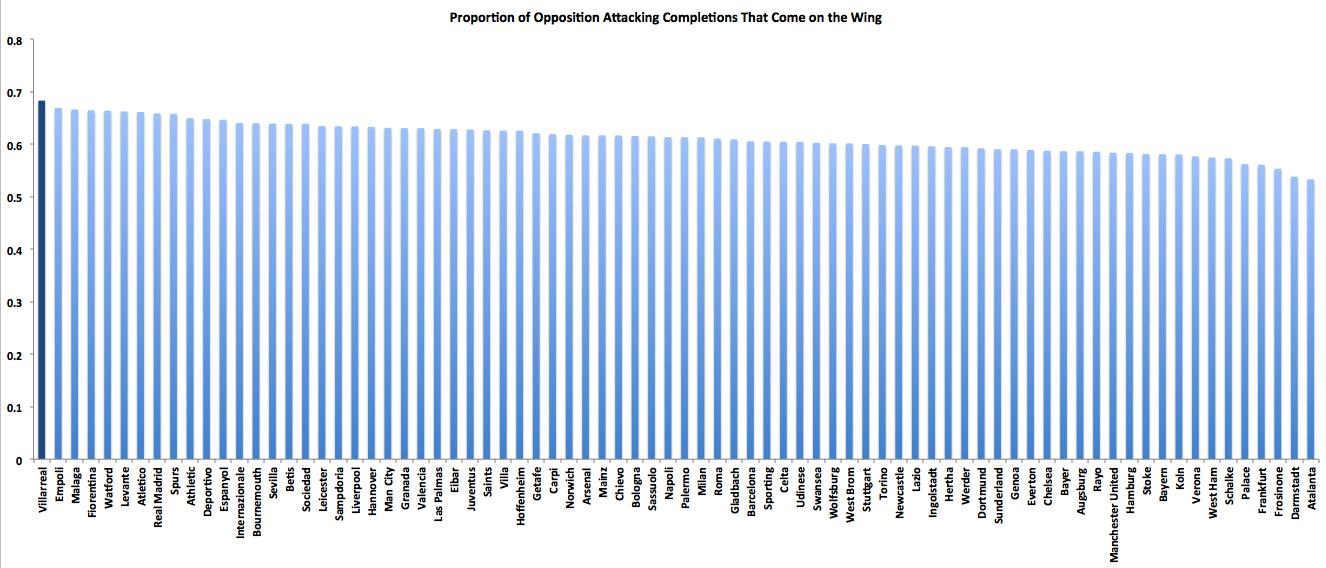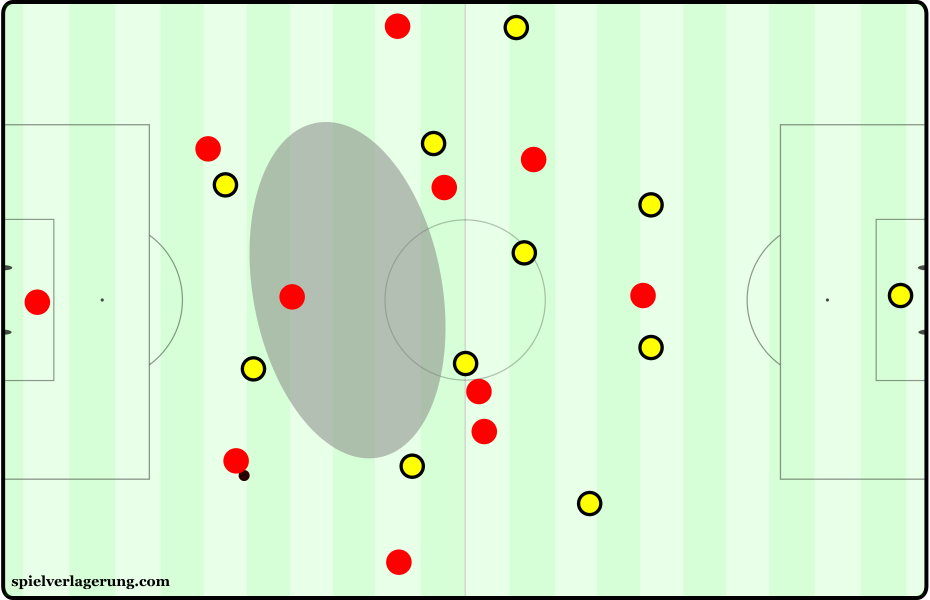Villarreal – Liverpool 1:0
Following a turbulent win over Dortmund in the previous round, Liverpool came into the next round as favourites for the competition. But the underrated Villarreal had no intention of rolling over, and provided a typically strong defensive performance to take a narrow 1-0 win after a last-minute winner from Adrian Lopez.
Villarreal’s defensive organisation
Only Barcelona & Atletico have conceded less goals in La Liga than Villarreal. There have even been comparisons between Villarreal and Diego Simeone’s team, with reference to their ultra-compact 4-4-2 systems. But whilst they operate with many of the same principles, Thursday’s match exhibited some of the areas in which Villarreal differ from Atleti.
The major difference between the two is their treatment of the space in front of their central midfielders. Whilst Atletico Madrid strikers are tasked with dropping deep & narrow in order to limit the space in this area, Villarreal opened this space by pushing Bakambu and Soldado into wider and more advanced areas during Liverpool’s first phase of build-up.
If the ball does reach this midfield space, then Atleti’s central midfielders will often aggressively push forward, relying on nearby teammates to slide laterally to cover the vacant space. However, Bruno Soriano and Tomas Pina maintained their deep position, particularly in defensive organisation. Joe Allen and James Milner both moved into advanced areas, and Soriano & Pina focused on closing the passing lanes to these players rather than pushing forward to confront the ball-player. This allowed Lucas more time on the ball.
But even with increased time on the ball to assess the situation, Lucas was unable to penetrate Villarreal’s midfield in central areas. This was partly due to good awareness from Soriano & Pina to ensure they were constantly aware of the situation behind them. This decreased the tempo of Liverpool’s build-up dramatically, and often resulted in a sideways pass to the full-backs. Occasionally Adam Lallana would drop deep into the large midfield space, and this quickened the tempo somewhat, but because of the lack of central passing options, still had the same result: play forced into wide areas.
Until the ball reached the wide areas in their final third, Villarreal’s central midfielders would only make subtle movements away from their position, to block the passing lanes to Allen & Milner. This position-oriented approach from Villarreal’s central midfielders also allowed Liverpool to create diagonal passing lanes into wide areas, and Villarreal did very little to stop this happening. At times, Villarreal’s full backs even seemed to encourage this diagonal pass by stepping out of the passing lane if Liverpool’s wide player was behind their cover shadow.
https://twitter.com/edAfootball/status/726040522423455744
This creates extreme horizontal compactness in the centre of the pitch, and increases the likelihood of a Milner to Clyne pass. A similar strategy was utilised by Villarreal’s wide midfielders, who would even step forward to create the diagonal passing lane and invite Liverpool wide. This feature of Villarreal’s play is not unique to the Liverpool fixture.

A chart from the excellent @SaturdayOnCouch – Villarreal’s ability to force opponents wide is amongst the best in Europe.
Villarreal regularly force their opposition to attack from wide areas. This is partly because these areas are strategically harder to attack from, but also because Villarreal are so well-drilled at re-structuring their defense once possession does move wide.
Once possession is moved wide, an initial 1v1 duel is created with the full back or wide midfielder shifting to confront the ball-player. But the LM & LCM drop into the vacated space to create extreme horizontal compactness. If the initial 1v1 duel is lost and Clyne (in this example) makes it past Costa, he will still have to cross from a less dangerous area rather than progress into the penalty box.
This focus on horizontal compactness was difficult for Liverpool to deal with. Much like when Villarreal forced Liverpool wide continuously, this compactness often meant the only option for the wide player was to re-circulate into midfield. Once this was forced, the Villarreal midfield would simply re-structure again. This passive approach is unlike other teams (such as Atletico), who aggressively harass the ball-player with defensive overloads once they force the ball to be shifted wide.
Costa-Suarez-Bakambu movement patterns
Villarreal had more success building play down their left side as their positional play on this side was more effective, due to the good spacing between Costa, Suarez & Bakambu. Each player’s movement would be triggered by the positioning and, more importantly, movement, of their teammates. There were several different movement patterns created with these principles in mind, but the primary focus was to get Denis Suarez the ball in the left halfspace, and the movements made replicated that intent.

Movement pattern example: Suarez makes the halfspace run, and Bakambu moves into the advanced wing area.
The particular runs made by each player were dictated by the key principles of positional play: not operating in the same space as your teammates. In the initial build-up phase, this was easiest to achieve for Costa & Bakambu because they have both teammates in their field of vision at once. But as the midfield player, Denis Suarez would have to glance both ways to fully assess the situation, which is not efficient.
Against Liverpool, Suarez focused on adjusting his movements to suit Costa, although his awareness of Bakambu’s positioning was also good. Costa almost always received the ball from a quick horizontal ball circulation, but this was not always in the same position. His depth was fairly consistent, but he could receive the ball in the halfspace or the wing. Denis Suarez had to adapt to this before Costa received the ball, and move to the opposite zone. If Costa was wide, Suarez moves into the halfspace, and vice versa.
Suarez had the additional benefit of altering his depth to create more potential combinations. In this fixture, his preferred movement was to move forwards into the halfspace, but receive the ball to feet when situated on the wing. For this second option, Costa would underlap to create a potential forward passing option, but more importantly, to create space for a 1v1 duel between Suarez and Clyne.
Bakambu also had an important role in adjusting to the positioning of both Costa & Suarez. He often moved into a wider position, and aside from creating good spacing with Suarez, this had the duel benefit of dragging the oft-man-oriented Dejan Lovren away from the centre of the pitch.

Another movement pattern created: Bakambu comes short & wide, Suarez goes long & narrow. Man markers follow and the defensive structure is destroyed.
Despite only featuring three players, this type of combination play creates many different combinations not mentioned here. And when Liverpool fell into temporary man-marking, the structure was ripped apart as Clyne moved inside to follow Suarez and Lovren drifted with Bakambu.
When executed correctly, this good collective spacing in-possession also allowed for potential counterpressing opportunities in all areas if the ball was lost. Rather than attempting to utilise this as a tool for regaining possession, Villarreal used the improved access to force a ball back to the goalkeeper to create time to re-structure into their 4-4-2 defensive shape.
When Soldado & Bakambu temporarily switched sides, this style of build-up was not nearly as effective. It was clear this was something trained with Bakambu specifically, and Soldado consistently moved into similar spaces as Suarez rather than adapting as Bakambu had done. Even when Suarez made the movement from the halfspace into an advanced wing area, Soldado made the same run, and the spacing (and therefore the potential combination play) was killed. This made it easier to cover the space for Liverpool, and Costa was forced into re-circulating possession along the backline or possession was lost.
https://twitter.com/edAfootball/status/726368773758980096
Roberto Firmino: forever out of view
One of the most controversial team selections from either side was Jurgen Klopp’s decision to leave Daniel Sturridge on the bench. Roberto Firmino instead started in the centre forward position. Firmino offers a very different skillset to Sturridge, and it created a very different type of game.
One of the key reasons Firmino was picked over Sturridge was his contribution to pressing phases. Whilst Sturridge is capable forcing the opposition wide, he rarely makes a direct contribution in winning the ball back. The Brazilian is an expert at loitering behind the ball-player, outside his field of vision, before quickly accelerating to win the ball back.
In the 64th minute, he was nearly able to utilise these same skills to score. Instead of attempting to win the ball back, he drifted behind the Villarreal defense and popped up again in an onside position to hit the post.
https://twitter.com/edAfootball/status/726367235938373632
But despite these positives, he was generally disconnected from the rest of his teammates. When he received the ball, it was in an isolated position amongst a number of Villarreal defenders. Whilst Daniel Sturridge often drifts wide in transition phases to increase his availability for a pass, Firmino stayed central and only moved wide in the final third in organisation phases. Because of Villarreal’s focus on horizontal compactness in the centre, this made it difficult for Liverpool to attack in transition. Bruno Soriano & Pina would then drop behind the ball and create the large space in midfield, closing the passing lanes and forcing Lucas to build play.
Conclusion
Both teams seemed content with a draw, and Villarreal’s passive defensive structure helped facilitate Liverpool’s desire to come away with a 0-0. But when Liverpool’s crumbled in defensive transition, Villarreal were happy to take advantage. Liverpool attempted to press in the centre of the pitch after losing a second ball, but none of the challenges closed potential passing lanes. Milner, Moreno & Lucas all rushed into challenges without winning the ball or removing any passing options, creating a transition opportunity for Villarreal. This isolated Denis Suarez 1v1 with Kolo Toure – something best avoided.





Keine Kommentare vorhanden Alle anzeigen